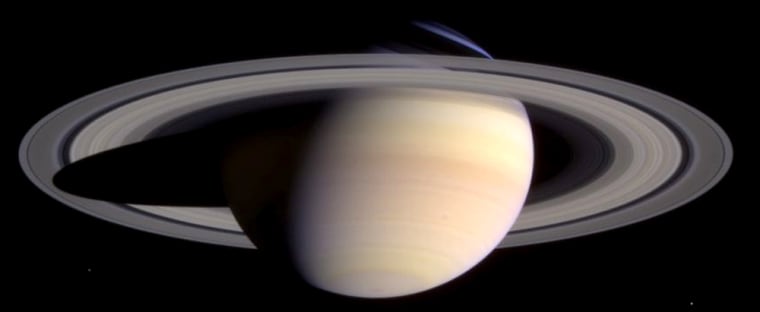NASA's Cassini spacecraft is getting close enough to Saturn to photograph subtle features in the ringed planet's atmosphere. A new image shows two small, faint dark spots that the craft hadn't detected before.
Cassini is due to arrive at Saturn July 1.
The new image, released today, was taken March when the spacecraft was then 35 million miles (56.4 million kilometers) from Saturn, slightly more than one-third of the distance from Earth to the Sun. The planet is 23 percent larger in this image than it appeared in the preceding color image, taken four weeks earlier.
The image shows Saturn in natural color. Contrast and colors were slightly enhanced, however, to make features more prominent.
The planet casts a stark shadow on its rings, which are made of icy particle ranging in size from dust to boulders and even small, embedded moons. Astronomers aren't sure how the rings were created.
The two dark spots are visible in the planet's southern hemisphere. Mission scientists expect them to become clearer in the coming months. Atmospheric spots on Jupiter and Saturn occur frequently and can last days, weeks or months. They are often akin to storms on Earth but, because the giant planets have no land to disrupt the flow of clouds, the storms or spots can endure for longer periods.
The spots are located at 38 degrees South latitude.
Some of Saturn's moons are visible in the lower half of the new image. Mimas, 247 miles in diameter (398 kilometers) at left, just below the rings; Dione, 695 miles across (1,118 kilometers) at left, below Mimas; and Enceladus 310 miles wide (499 kilometers) at right. The moons have had their brightness enhanced to aid visibility.
Cassini will study Saturn's atmosphere, rings and moons and is expected to discover new, small moons within the rings.
Piggybacked on the spacecraft is the Huygens probe, which will descend into the atmosphere of Saturn's largest Moon, Titan, early next year. The probe may land on a hard surface or perhaps on a strange sea with huge waves.
The Cassini-Huygens mission is a cooperative project of NASA, the European Space Agency and the Italian Space Agency. The Jet Propulsion Laboratory, a division of the California Institute of Technology in Pasadena, manages the project for NASA. The imaging team is based at the Space Science Institute, Boulder, Colorado.
